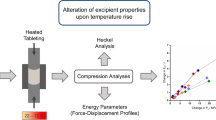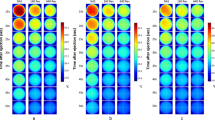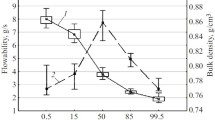Abstract
Purpose. Thermophysical properties of three tableting excipients; microcrystalline cellulose, lactose and dicalcium phosphate dihydrate were observed to evaluate their ability to resist temperature induced changes in tablet form.
Methods. Two thermophysical parameters, thermal diffusivity and specific heat, were measured by a pulse heating method. The materials were also evaluated by differential scanning calorimetry (DSC).
Results. Microcrystalline cellulose in tablet form was found to be rather insensitive to heating and cooling treatments, even though the tablets seemed to remain in a stressed state four weeks after tableting. This stress, indicated by low temperature anomalies, was observed by the pulse method, but not by DSC. When magnesium stearate was incorporated as a lubricant within the microcrystalline cellulose powder, the thermophysical parameters indicated that the internal structure of the tablets changed with heating and cooling. Magnesium stearate eliminated the low temperature anomalies as well. The heat treatment changed the thermophysical properties of tablets made of the crystalline excipients lactose and dicalcium phosphate dihydrate, permanently causing irreversible structural changes.
Conclusions. The melting of the lubricant together with enhanced stress relaxation in the structure of microcrystalline cellulose most probably caused the improved thermal diffusivity. The observed thermophysical changes with the crystalline excipients were due to changes in tablet's structure and material. The combination of methods used was found to be an accurate and reliable way to obtain useful information on the structural changes and material relaxations of intact tablets during temperature treatment and age-related changes in material properties.
Similar content being viewed by others
REFERENCES
E. Nürnberg and A. Hopp. Temperature measurement during tableting. Pharm. Technol. 168:81–101 (1981).
J. Ketolainen, J. Ilkka, and P. Paronen. Temperature changes during tabletting measured using infrared thermoviewer. Int. J. Pharm. 92:157–166 (1993).
J. R. Britten and N. Pilpel. Effects of temperature on the tensile strength of pharmaceutical powders. J. Pharm. Pharmacol. 30:673–677 (1978).
S. Esezobo and N. Pilpel. The effect of temperature on the plasto-elasticity of some pharmaceutical powders and on the tensile strength of their tablets. J. Pharm. Pharmacol. 38:409–413 (1986).
L. Kubicar. Applications of the pulse method. In G. Svehla (ed.), Pulse method of measuring basic thermophysical parameters, Elsevier, Amsterdam, 1990, pp. 231–267.
L. Kubicar, J. Spisiak, and D. Krivankova. Investigation of the structural relaxations of materials. High Temp. High Press. 23:249–254 (1991).
C. Nyström, G. Alderborn, M. Duberg, and P.-G. Karehill. Bonding surface area and bonding mechanisms—Two important factors for the understanding of powder compactability. Drug Dev. Ind. Pharm. 19:2143–2196 (1993).
L. Kubicar and J. Spisiak. Measurement of thermophysical properties of solids by the pulse method, High Temp. High Press. 20:619–626 (1988).
S. W. Hoag and E. G. Rippie. Thermodynamic analysis of energy dissipation by pharmaceutical tablets during stress unloading. J. Pharm. Sci. 83:903–908 (1994).
I. Krycer and J. A. Hersey. Detection of mechanical activation during the milling of lactose monohydrate. Int. J. Pharm. Tech. Prod. Mfr. 2:55–56 (1981).
H. Vromans, A. H. de Boer, G. K. Bolhuis, C. F., Lerk and D. D. Kussendrager. Studies on tableting properties of lactose; The effect of initial particle size on binding properties and dehydration characteristics of α-lactose monohydrate. Drug Dev. Ind. Pharm. 12:1715–1730 (1986).
P. Di Martino, S. Martelli, A.-M. Guyot-Hermann, J. C. Guyot, M. Drache, and P. Conflant. The batch-to-batch non-reproducibility of the compression ability of lactose. Reasons and detection. S. T. P. Pharma Sci. 3:436–441 (1993).
R. Hüttenrauch and I. Keiner. Producing lattice defects by drying process. Int. J. Pharm. 2:59–60 (1979).
C. F. Lerk, A. C. Andreae, A. H. de Boer, G. K. Bolhuis, K. Zuurman, P. de Hoog, K. Kussendrager, and J. van Leverink. Increased binding capacity and flowability of α-lactose monohydrate after dehydration. J. Pharm. Pharmacol. 35:747–748 (1983).
M. Landín, R. Martinez-Pacheco, J. C. Gomez-Amoza, C. Souto, A. Concheiro, and R. Rowe. The effect of country of origin on the properties of dicalcium phosphate dihydrate powder. Int. J. Pharm. 103:9–18 (1994).
Author information
Authors and Affiliations
Rights and permissions
About this article
Cite this article
Ketolainen, J., Kubičár, L., Boháč, V. et al. Thermophysical Properties of Some Pharmaceutical Excipients Compressed in Tablets. Pharm Res 12, 1701–1707 (1995). https://doi.org/10.1023/A:1016261605023
Issue Date:
DOI: https://doi.org/10.1023/A:1016261605023




